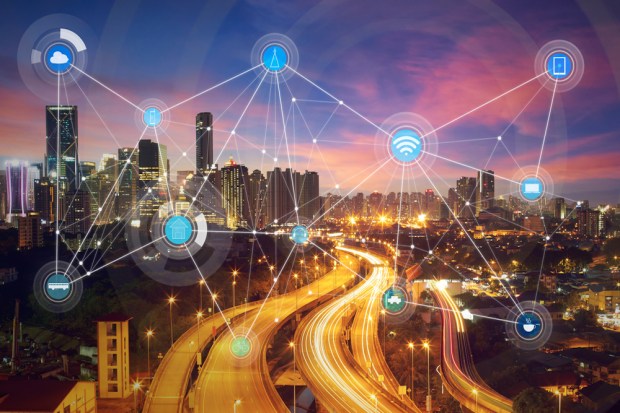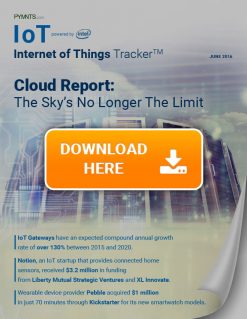Cloud Report: The Sky’s No Longer The Limit

Let’s call it “disconnected connectivity” – sort of like jumbo shrimp, but in the cloud … and having nothing to do with shrimp. Yet, as IoT solutions continue to detach services from devices, tech players are redefining what it means to be “connected.” The PYMNTS June Internet of Things TrackerTM profiles 80 players who are connecting an increasingly “disconnected” world – and an insider’s view on how IoT will influence the future of payments from Will Wang Graylin, Global Co-GM of Samsung Pay.
Alexa, the voice-activated ecosystem from Amazon that allows consumers to engage with devices in a natural, seamless manner, represents the cutting edge of integrated technology. While Alexa was originally introduced via Amazon’s Echo device, it’s cloud-based, meaning integration limitations are essentially nonexistent when paired with other IoT solutions.
It was this broad potential for IoT innovation that inspired the PYMNTS 2016 Alexa Challenge. The competition invited players from across the IoT spectrum to use Alexa’s voice-activated features to expand the boundaries of connected technology.
The opportunity to be a pioneer in the push toward integration was seized by participants like the ONvocal/People Power team, a two-company collaboration that worked with ONvocal’s hardware (called OV) and People Power’s IoT platform to explore uncharted technological territory. PYMNTS recently caught up with Will Wang Graylin, Global Co-GM of Samsung Pay and longtime investor and board member to both People Power and ONvocal, to discuss the companies’ integrated endeavors and the future of integrated homes.
Pioneering the IoT push
While the ONvocal solution – “an acoustic interface IoT device” – was enhanced through PYMNTS’ Alexa Challenge, its seeds were planted long ago, during Graylin’s days as an MIT student.
Fueled by a longtime interest in the technology of acoustics, Graylin studied under Dr. Amar Bose, the sound engineer best known for founding the speaker company of the same name. After digging into the science of sound, Graylin felt inspired to move beyond fixing amplifiers and constructing speakers and decided to apply the knowledge to his other area of interest: mobile technology and, by association, IoT.
“I’ve had a passion for connected devices for a long time. Naturally, an extension of mobile is connected devices,” he said.
After launching a career in the mobile space, Graylin identified an area of portable tech in need of an acoustic upgrade – the Bluetooth headset.
“I tried just about all the major Bluetooth devices in the past. Usually they were either good for phone calls but not good for music and vice versa, or good for airplanes but not for working out and vice versa,” Graylin said.
Graylin found that most Bluetooth devices lacked not only “quality of sound” but also “quality of functionality and adaptability.”
For example, business travelers trying to make calls in an airport would want an acoustic interface that could drown out travel noises – while still allowing them to be heard clearly by whoever is on the other end. By the time users board the plane, however, they’re ready for the power of noise-canceling technology so they can nap or enjoy music. And when they exit the plane, they want to keep their music on, but also be able to hear external noises while they grab their luggage and adapt to new surroundings.
The absence of customizable features in traditional Bluetooth technology means that sound settings are standard no matter who the user is. From the airport to the plane to the hotel room, the same quality and level of sound is being sent and received.
The (unobstructed) sound of innovation
In addition to offering a more acoustically advanced option to traditional Bluetooth headsets, Graylin, alongside fellow tech innovators Brad Geswein, Bob Spaner and John Maddox (whose backgrounds include working with Klipsch, Bose and Sonos), wanted to create a solution that could integrate with the AI voice systems out there seamlessly for consumers.
“Today, anyone can click a command and use Siri or Google Voice,” he explained. “But there isn’t any device with a dedicated voice channel to interface with the plethora of artificial intelligence systems out there,” he said. “For example, Alexa. How do you create a dedicated channel to invoke services like Alexa? We wanted to do that.”
Enter OV. The headset and accompanying app, which is slated for release later this summer, offers 360 degrees of “binaural” listening, which allows users to hear precisely where the surrounding ambient sounds are coming from.
The headset contains three microphones – one “boom” mic to pick up the user’s own voice for better performing calls or for singing along to songs, and one mic in each earbud to give users real-time 360 degree ambient sounds around them. It can go from sounding like traditional earbuds, which let in some background noise, to completely blocking out the world in the style of noise-canceling devices.
The ONvocal team wanted to create a product that was truly integrated in order to elevate convenience and user experience, so in addition to being designed according to stringent acoustic standards, OV was also created with voice command, and Alexa, in mind.
“We dedicated both a hardware button and an electronic channel to be able to communicate and create great experiences for those types of interactions using this IoT device. Now there’s truly this flexibility of, ‘I don’t have to touch my phone.’ It could be in my pocket, my purse, I could click a button and it would start interacting naturally with my voice, and I can choose which service I want, and not just the service that comes with my phone,” Graylin explained.
The team has now integrated the hands-free hardware of OV with the voice-powered features of Alexa, creating a service that offered on-the-go control in a sophisticated acoustic environment.
Bringing IoT home
While OV was created for on-the-go use, its hands-free, Alexa-enabled technology is being leveraged by People Power to improve IoT connectivity in the home.
According to Graylin, an integrated acoustic interface device lays the foundation for effective IoT connectivity. Like a touchscreen or keyboard, an acoustic interface acts as the bridge between users and the cloud. The key difference is that the former tools require users to be physically engaged, while the latter is powered purely by vocal commands.
For People Power and other IoT platforms, homes are brimming with IoT technology opportunity. Security, power management and senior care are all areas that the IoT services company is looking to enhance and streamline through integrated solutions. Along with OV, People Power is developing an integrated senior care solution called ProCare, which works in conjunction with the Amazon Echo, and should hit the market in a few months.
“Once it’s finalized as an Alexa ProCare (and ProSecurity) companion, you’ll be able to use your Echo device, as well as the OV device, to remotely access and control your People Power Presence Care service. And that includes, when you’re at home, one of the great service we think is especially important for elderly, which is the ability to use your voice to call for help,” Graylin said.
While the device draws inspiration from traditional senior care solutions – which often take the form of wearables – its hands-free design and IoT integration sets it apart. As long as users are within vocal range of Echo, they’re able to communicate and seek help.
By calling out for emergency assistance via Alexa, the user activates the Presence ProCare solution, which immediately places calls to pre-determined loved ones and emergency services. In the case of false alarms, users will have a short window of time during which they can cancel the calls via the Presence app. Once the window passes, first responders are dispatched.
IoT fever – catch it
When Graylin talks about innovators creating solutions for a connected future, he’s clearly excited about the march toward IoT integration.
“It’s a very exciting time for these companies that are bringing IoT solutions into the world,” he said. “It’s very exciting to see new technologies like this coming about and tapping into the power of AI and IoT, and all of the things that are happening around us, even AR and VR. All of these things are coming together with connected devices.”
To download the Tracker, click the button below:
About the Tracker
The PYMNTS.com® Internet of Things Tracker, sponsored by Intel®, showcases companies that are leading the way in all aspects of the Internet of Things. Every month, the Tracker looks at what these companies are doing across the ecosystem and in six categories: Devices; Infrastructure; Payments; Security; Software; and Data.

